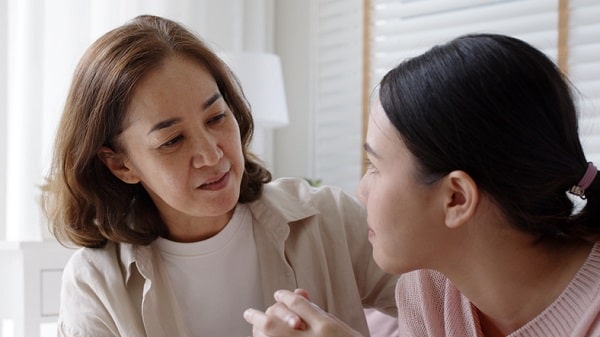© 2021 Gwen Dewar, Ph.D., all rights reserved

Families are better off when teenagers communicate openly with their parents. But how do we inspire better communication? An experimental study shows the way: We need to provide kids with crucial signals of active, supportive listening. Not only does it make kids feel better. It also encourages them to confide in us.
Adolescence can be a rough time. Many kids wrestle with emotional problems, and some develop behavior problems. How can parents help?
Sensitivity and responsiveness are important (as I explain elsewhere, it can protect your child from toxic stress).
It’s also important to recognize your teen’s increasing needs for autonomy.
And one of the most fundamental components?
Talk. Open, friendly, effective communication.
Such high-quality communication can improve relationships, and keep parents informed about the challenges their children face. It can also help a child cope with difficult emotions.
On the flip side, communication deficits linked with negative outcomes. For example, consider the type of trouble that psychologists label as “externalizing behavior” — behavior that is disruptive, aggressive, or anti-social.
All around the world — in places as different as China, Italy, Kenya, Sweden, and the United States — kids are more likely to develop externalizing behavior if they are in the habit of keeping secrets from their parents (Kapetanovic et al 2020).
So how can we improve the quality of parent-child communication?

A recent study offers some answers.
Netta Weinstein and her colleagues were interested in the ways that parents listen to their kids. How does parental listening affect teens?
In particular, the researchers wanted to contrast moderate-quality, semi-distracted listening with something different: Visibly attentive, empathic, high-quality listening.
So they created a set of naturalistic, videotaped vignettes for kids to watch — conversations between a teenager and his mother.
There were four vignettes in total, with each depicting a somewhat different scenario:
- A confession with high-quality parental listening. The teen shares his remorse about vaping, and his mother displays caring, attentive listening behavior.
- A confession with only moderate-quality parental listening. The teen shares the same feelings mentioned above, but his mother is more distracted.
- A disclosure of hurt feelings with high-quality parental listening. The teen shares his alienation and hurt feelings after being rejected by peers (for refusing to vape). The mother shows excellent listening skills throughout.
- A disclosure of hurt feelings with only moderate-quality parental listening. The teen tells the same story, but in this case the mother responds in a more distracted way.
The vignettes were completed with the help of twelve specialists, including researchers, therapists, and consultants. Then the researchers moved onto the next phase:
They recruited more than 900 adolescents in the United Kingdom — kids between the ages of 13 and 16 — and randomly assigned each teen to watch just one of the vignettes.
So each kid watched the video that had assigned to him or her. Then the teenagers were asked to rate their agreement or disagreement with a series of statements like these:
- “If I were the young person in this situation talking to my mum, I would feel closeness and intimacy.”
- “If I were the young person in this situation talking to my mum, I would feel free to be who I am.”
- “If I were the young person in this scenario talking, I would feel that I am a failure.”
Teens were also asked for their opinions about future openness:
“How much, if at all, do you think the child in the video would tell their mum the following things in the future after the conversation they had?”
What did kids say?
Their answers depended, in part, on how the mother had behaved in the videotaped vignette.
When the mother showed high-quality listening skills, kids reported feelings of greater closeness, autonomy, and self-worth. And — crucially– they were also much more likely to predict that the teen in the story would continue to share things with his mother in the future.
This was true for both the “confession” and “hurt feelings” conversations. And the difference that high quality listening made was substantial, with medium-sized effects on closeness and well-being, and large effects on predictions of future disclosure.
It adds up to a hopeful message. We can enhance communication with our teenagers by being good listeners. But what does it mean to be a good listener?
The takeaway: A checklist of listening signals to send when you are communicating with your teen

As Netta Weinstein and her colleagues explain, high-quality listening means that we make people feel safe and supported. We provide them with clear evidence that we’re paying attention. We allow them to express their feelings without acting negative (Weinstein et al 2020; Itzchakov et al 2018).
How do communicate these things? Mostly via non-verbal signals called “back-channeling,” including these signals highlighted in Weinstein’s study:
- Make consistent eye contact with the person who is talking.
- Use body language that expresses openness and receptivity. Lean forward, tilt your head forward.
- Indicate that you understand the speaker’s meaning by nodding your head, or making little nonverbal sounds like “mmm-hmm” or “ah.”
- Display friendly intentions by making statements of support, such as, “Thanks for sharing that with me. I imagine it wasn’t easy for you.”
What if your child confesses to doing something bad?
Good listening is the first step. The next is to find constructive ways to correct the misbehavior. Anger, shaming, harsh punishments — there is little evidence that these work. On the contrary, they tend to make things worse.
For help, see my article about coping with externalizing problems, as well as the Parenting Science guides to positive parenting.
References: How to communicate with your teenager
Itzchakov G, DeMarree KG, Kluger AN, Turjeman-Levi Y. 2018. The Listener Sets the Tone: High-Quality Listening Increases Attitude Clarity and Behavior-Intention Consequences. Pers Soc Psychol Bull. 2018 May;44(5):762-778.
Kapetanovic S, Rothenberg WA, Lansford JE, Bornstein MH, Chang L, Deater-Deckard K, Di Giunta L, Dodge KA, Gurdal S, Malone PS, Oburu P, Pastorelli C, Skinner AT, Sorbring E, Steinberg L, Tapanya S, Uribe Tirado LM, Yotanyamaneewong S, Peña Alampay L, Al-Hassan SM, Bacchini D. 2020. Cross-Cultural Examination of Links between Parent-Adolescent Communication and Adolescent Psychological Problems in 12 Cultural Groups. J Youth Adolesc. 2020 49(6):1225-1244.
Weinstein N, Huo A, and Itzchakov G. 2021. Parental Listening When Adolescents Self-Disclose: A Pre-Registered Experimental Study. Journal of Experimental Child Psychology. DOI: 10.1016/j.jecp.2021.105178
Content last modified 7/5/2021
image credits for “How to communicate with your teen: Key signals to send”
title image of mother talking teen daughter by Chaay_Tee / istock
closeup image of listening mother by CREATISTA / istock
image of father listening to son by Snesky / istock